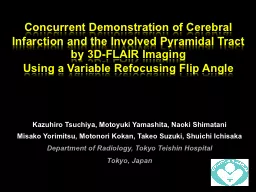PPT-Concurrent Demonstration of Cerebral Infarction and the Inv
Author : min-jolicoeur | Published Date : 2016-04-19
Using a Variable Refocusing Flip Angle Kazuhiro Tsuchiya Motoyuki Yamashita Naoki Shimatani Misako Yorimitsu Motonori Kokan Takeo Suzuki Shuichi Ichisaka
Presentation Embed Code
Download Presentation
Download Presentation The PPT/PDF document "Concurrent Demonstration of Cerebral Inf..." is the property of its rightful owner. Permission is granted to download and print the materials on this website for personal, non-commercial use only, and to display it on your personal computer provided you do not modify the materials and that you retain all copyright notices contained in the materials. By downloading content from our website, you accept the terms of this agreement.
Concurrent Demonstration of Cerebral Infarction and the Inv: Transcript
Download Rules Of Document
"Concurrent Demonstration of Cerebral Infarction and the Inv"The content belongs to its owner. You may download and print it for personal use, without modification, and keep all copyright notices. By downloading, you agree to these terms.
Related Documents














